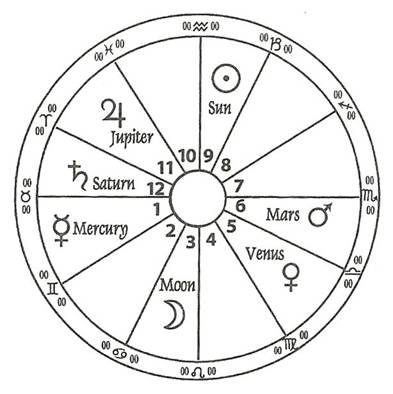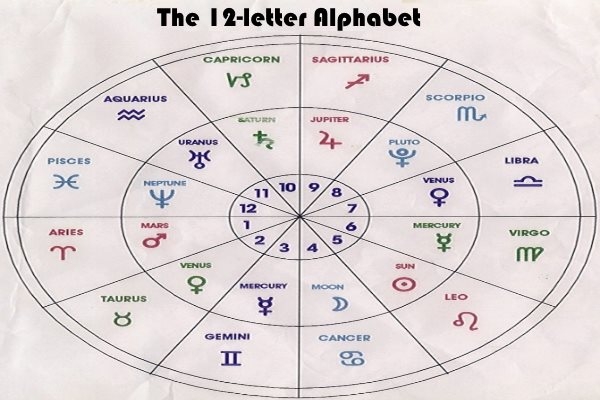By: Joseph Crane
The Twelve Letter Alphabet, sometimes called the twelve “Archetypes,” underlies much of the presentation of planets, signs, and houses in modern Western astrology. In my view, this has led to the distortion of much of astrology’s fundamental symbolism. Many other astrologers have come to the same conclusion, yet this system persists.
This article, the result of many years of frustration with the conventional presentation of astrology, has as its goal that astrologers question their explicit and implicit use of the Twelve Letter Alphabet. A case can be made for putting this system away forever, and I attempt to make that case here. For newer students I’d like this article to be a “patch” to decrease their confusion and help them think things through when they encounter different versions of astrological symbolism. For more experienced astrologers and astrology teachers, I would like to stimulate some long-overdue conversation.
What is the Twelve Letter Alphabet?
When stated nakedly, this doctrine maintains that the Planets = Signs = Houses. For example, the First House is of the same nature as Aries and its ruling planet Mars, called the “First Letter”; the Second Letter is made from the Second House, Taurus, and Venus, and so on up to the Twelfth House, Pisces, and Neptune. Following this model, we sometimes read statements such as “the Second House is like Venus,” the “Eleventh House or Aquarius,” and so forth. When astrology books describe a particular planet’s placement through houses and signs, e.g. “Pluto (or other planet) in Leo or the Fifth House”, their authors are making a correspondence of particular planet and the house based on the Twelve Letter Alphabet.
One can also use the Twelve Letter Alphabet for interpretative purposes. My natal chart has Neptune in the first house and Mars in Pisces. According to my first astrology teacher, this means that in my natal chart the First House and Mars are modified by the Pisces/Neptune influence, so that I have problems with anger or motivation, or maybe I’m passive aggressive. I was struck by this interpretation’s seductive simplicity, and also that it was wrong.
This particular blending of houses with signs (and their ruling planets) took root in traditional medical astrology, whereby either Aries or the First House is significator of the head, Taurus or Second House significator of the throat, etc. Centuries later, perhaps beginning with The Astrology of Personality (1936), Dane Rudhyar differentiated between “event-oriented” and “humanistic” perspectives on the astrological houses and recast all the traditional house depictions to fit psychological and spiritual interests. In the early 1970’s astrologer Zipporah Dobbyns articulated the Twelve Letter Alphabet that was linked with interpreting a natal chart from psychological or spiritual points of view.
Surely, one can take a psychological approach to natal astrology without resorting to the Twelve Letter Alphabet. Much of my astrological work over the past 20 years has been to demonstrate the importance of the “condition of the soul” in the natal astrology of previous eras, and the effectiveness of its techniques for that purpose. Additionally, when the Twelve Letter Alphabet has taken over as the template for astrological symbolism, other fields of astrology (horary, electional, and event astrology) take on a diminished value. It is important to note that these branches of our art are concerned mostly with external situations, not the processes of psyche and soul. When learning these important branches of astrology, people should not have to learn astrology all over again to apply its symbols outside the psyche.
“You’re just promoting traditional astrology over modern astrology – once again.”
You might say.
“No,” I reply,
“I am promoting astrology as it is,
with a long heritage and coherent symbol system
that is relevant across all applications of astrology.
We just need to find out more about it.”
 Many astrologers state that the Twelve Letter Alphabet should be used carefully, because houses are not exactly signs and ruling planets aren’t signs either. Thus you might say, “A lot of presentations say that the Twelve Letter Alphabet is a good teaching tool for new astrology students but one shouldn’t take it too far, so what’s the problem?” Well, if a “teaching tool” is not to be trusted in actual practice on and can create misunderstanding, why use it at all?
Many astrologers state that the Twelve Letter Alphabet should be used carefully, because houses are not exactly signs and ruling planets aren’t signs either. Thus you might say, “A lot of presentations say that the Twelve Letter Alphabet is a good teaching tool for new astrology students but one shouldn’t take it too far, so what’s the problem?” Well, if a “teaching tool” is not to be trusted in actual practice on and can create misunderstanding, why use it at all?
Throughout astrology’s history there have been other ways to look at houses and planets together. Students and professional astrologers are often surprised that in the past the first house was sometimes correlated with Saturn, the second with Jupiter, and so on, in the descending order of the planets. (Try it out for all Twelve Houses – it doesn’t work too badly.) A more attractive system, however, is that of the house joys shown in the diagram on the left. Each of the seven visible planets has a favorite house to inhabit. This works far more powerfully than the Twelve Letter Alphabet to understand the connection between planets and houses, and so I will present the house joys throughout this article.
Letter by Letter
By tying together the separate threads of signs, planets, and houses the Twelve Letter Alphabet has created knots that need to be untied for astrology to be coherent. For this article I take my inspiration from a fine series of columns by Glenn Kessler in the Washington Post called “The Fact Checker”. It bestows different numbers of “Pinocchios” to politicians’ statements and advertisements based on degrees of untruth. Here, the more knots you see, the “knottier” are the problems correlating house, sign, and governing planet according to the Twelve Letter Alphabet.



